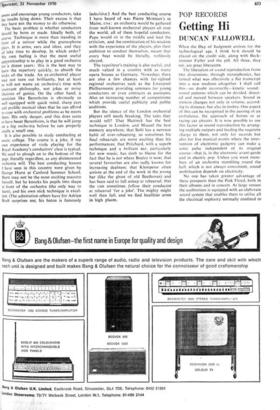POP RECORDS
Getting Hi
DUNCAN FALLOWELL
When the Day of Judgment arrives for the technological age, I think hi-fi should be placed on the credit side, along with Buck- minster Fuller and the pill. All three, they say. are great liberators.
The liberation of sound reproduction from two dimensions, through stereophonics, has turned what was effectively a flat transcript into a new medium altogether. I shall call this—no doubt incorrectly—kinetic sound: sound patterns which can be divided, direct- ed and moved between speakers. Sound in motion changes not only in volume, accord- ing to distance, but also in timbre. One aspect of this can be recognised in the passing of an ambulance, the approach of horses or at racing car circuits. It is now possible to use this factor in sound reproduction by arrang- ing multiple outputs and feeding the requisite charge to them, not only for records but also for live musical events where the inter- " vention of electronic gadgetry can make a sonic pulse independent of its original source—that is, in the electronic avant-garde and in electric pop. Unless you want mem- bers of an orchestra stumbling round the hall, which is not always convenient, sound mobilisation depends on electricity.
No one has taken greater advantage of these prospects than the Pink Floyd, both in their albums and in concert. At large venues the auditorium is equipped with an elaborate sound system that enables them to utilise all the electrical sophistry normally confined to
the studio workshop. Often with the addition of pre-recorded material, the music travels and floats among fifty or so speakers to create a composition not only in time but also in space. Pink Floyd's recent tour of America— with many tons of equipment in tow—was an enormous success because, apart from the beauty of the music, there is no one in American rock (how loosely we now must use the term 'rock') working at the same creatively adventurous level. For this natural extension of stereophonics they have con- trived the phrase 'quadraphonic sound'.
Yet it is remarkable how many of these qualities can be conveyed through a simple two-speaker stereo-gramophone. In the first place, of course, the sound grows immeasur- ably in richness and strength by splitting its source—usually between bass and treble but not always. With an acoustic ensemble (orchestra, folk group, string quartet, what- ever) this is all that is necessary. Anything else is an intrusion.
Such an intrusion has been attempted, with feeble results. I recall those awful Switched- on Bach records from cas, or bits of freaked- up Berlioz and Stravinsky on Classical Heads (Charisma, 39s 11d, if you're interested), Alternatively, music composed especially for the electrical media I should expect to deploy techniques appropriate to them. In these circumstances, devices like fuzz-boxes, miters and echo-chambers become part of the musician's legitimate wardrobe.
Stereo is at its most dramatic when the number of musical elements is small (as in a rock group of four or five) so that each acquires greater independence. One of the more disconcerting moments in Pink Floyd's Ummagamma (double album, Harvest, 59s 11d), occurs when someone crosses the room to swat a buzzing fly. Since the action is isolated, it is easily placed in space. His footsteps are gradually phased from one speaker to the other and simultaneously brought closer to the microphone (i.e. you). The effect is to trace a diagonal line of approach towards the listener who is then swatted. (On second thoughts, like Pozzo's St Ignazio ceiling, perhaps it only works if you are in the correct position.) In the Beatles' very good, much abused Revolution 9 (from the white double album, Apple Records, 80s), they created a collage of 3-D sound which couldn't really be heard except in 'stereo. Using—not for the first time in music and alas not for the last- Burroughs's cut-up fold-in technique, they added extensive back-play of the original theme (Revolution 1); and, by inverting the musical thrust, produced some very pleasing sucking sensations, all for the greater glory of hi-fi. This duality is maximised by head- phones but music experienced in this anti- social way loses out on depth and resonance.
Such complexity in production demands, you might suppose, good producers. In the extreme case of John Cage, the music is all production because he simply processes or 'produces' sounds fed to him from the environment via the 1 Ching. But in these territories generally the roles of composer- performer-producer overlap to such a degree that ideally—as is, indeed, the case with Pink Floyd—all three should be the same.
When they are not, record producers don't always receive the credit they deserve, al- though George Martin, with opulent new studios above Oxford Circus, seems to do rather well. Since he was the fifth Beatle perhaps that doesn't altogether come as a surprise,















































 Previous page
Previous page